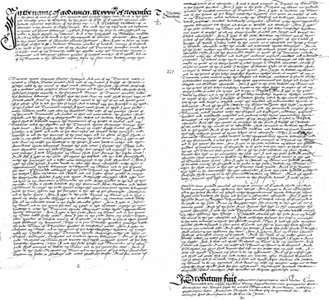Daniel Wilbur's Ancestors |
Click on a name for info, click on an arrow to follow that branch, click Home to go to the main page, or click for an Alphabetic List of all Names. |
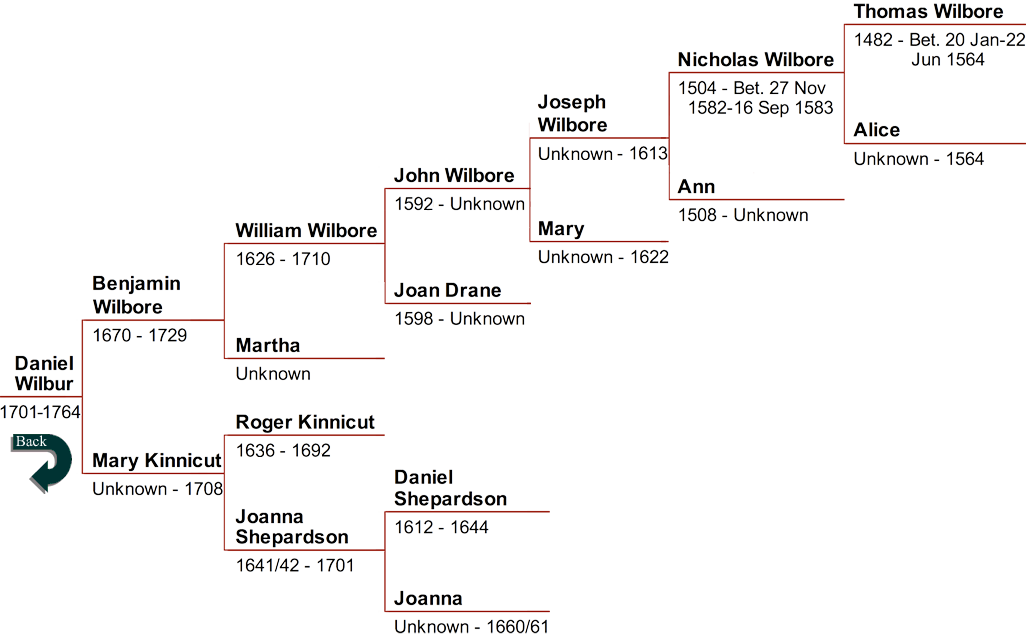 |
| Note: Before 1752 the year began on March 25th. Dates between January 1st and March 24th were at the end of the year, not the beginning. |
On November 2, 1710, Benjamin married Elizabeth Head in Portsmouth. it is believed that they had ten children together. It is difficult to know exactly how many there were and where they were born because some of their births were recorded in both Dartmouth and Portsmouth. For some reason James N. Arnold included the names of Benjamin and Elizabeth’s children who were born in Dartmouth in his Vital Record of Rhode Island under the Little Compton records, and included estimated birth years, which in some cases were not correct. This researcher believes the first four of their children were born in Portsmouth, the rest in Dartmouth, Bristol, Massachusetts, as follows – Abigail born September 9, 1711; Barsheba, about 1713, who married in 1731/32; Henry on August 29, 1716; George on September 23, 1718; Elizabeth, the first to be born in Dartmouth, on September 12, 1720; Mary, on July 6, 1722; Joseph, April 3, 1725; Walter on June 30, 1727, who died at 21 years-old on June 17, 1749; and Maribah on August 22, 1729, who was born after her father’s death and who James Arnold recorded as Ruth in Little Compton. The authors of The Wildbores In America tell us that Benjamin and Elizabeth kept the land given to him by his father until 1714. It can only be assumed they lived on it and raised both Mary’s and their own children there. The next we know, on June 2, 1714, Benjamin was buying 210 acres of land in Tiverton, Bristol County, Massachusetts. About this same time, he began selling off his Portsmouth land. On December 1, 1719, Benjamin sold 44 acres. The next day he sold 62 acres of land. A few days later on December 9th, Benjamin is buying land in Dartmouth. About a month later on January 14, 1719/20, Benjamin Wilbor of Portsmouth was buying more land in Dartmouth. It was about this time that the family moved to Dartmouth, probably without Mary’s children. Benjamin’s sons by his first marriage were now between 12 and 19 years old, and probably already placed in apprenticeships, as they all went on to marry in Portsmouth. On December 24, 1720, Benjamin and Elizabeth were living in Dartmouth with their five children and sold more land in Portsmouth including two small islands called Spectacle Islands. Benjamin wrote his will in Dartmouth, on April 1, 1729. This researcher has not seen the original will, but has found three snippets of it from The Genealogical Dictionary of Rhode Island, the second edition of The Wildbores in America, and the Abstracts of Bristol County, Massachusetts Probate Records, 1687-1745. Each source gives us a glimpse of parts of the will, which this researcher has tried to piece together. Firstly, Benjamin assigned his wife Elizabeth and under-aged son Henry as executors. Next, he left to his wife Elizabeth, “one-half of the income profits of my homestead farm and use of one-half of my dwelling house, half of profit of livestock, and if she marry to surrender her executorship to son Henry. To her also, £10, a year, feather bed, cow, riding mare and £15.” To his sons from his first marriage he left: ancestor Daniel, £60; William, “land in Dartmouth, joining land of James Akin, William Durfey and Thos. Briggs, Jr; Benjamin, land in Tiverton, 120 acres;” and to son Samuel, “certain land in Newport., R.I., that I purchased of Benjamin Bull.” To his children by his second marriage, he left: Henry, “all my homestead, farm and dwelling house, orchards, &c., and 160 acres of land in Dartmouth and all my live stock;” George was to receive £140; Joseph and Walter to get £150 each; Abigail, Bathsheba Elizabeth and Mary to receive “£50, and a feather bed and cow, at age;” and lastly “My wife being now with child,” this unborn child, who turns out to be Maribah, would receive £150, if “it a male, and a feather bed, cow and £50, if a female. The younger children to be brought up, and apprenticed at thirteen. To wife and son Henry rest of estate.” This last statement about the younger children going into apprenticeships at age 13, supports the theory that Benjamin left his first wife’s sons in Portsmouth. Benjamin died in Dartmouth sometime after the will was written and the inventory of the estate was taken on June 19, 1729. The estate was valued at £596, 7s, 2d., and included: “purse and apparel £20, 3s., 6d., negro £90, 6 silver spoons, 4 spinning wheels, quilting wheel, cheese press, 15 cows, pair of oxen, 15 young cattle, 8 calves, 6 horsckind, 84 sheep, 30 lambs, 7 swine, &c.” The will was proved on December 1, 1729. On March 19, 1734, The account of his widow Elezebeth Wilbore, Exec. of Est. of Benjamin Wilbour of Dart., included payments of legacies to Daniel Wilbour, Abigail Wilbour (£60) now Abigail Lapham, and Barsheba Wilbour, now Richetson. Some researchers believe this is when Elizabeth died, but it should be noted that death records in Dartmouth for both Benjamin and Elizabeth cannot be found. |
| ~< Back to Chart >~ |
Mary Kinnicut’s birth date and place are unknown. Three of her siblings were born in Malden, Middlesex County, Massachusetts, but her parents left there in 1679 and settled in Swansea, Bristol County Massachusetts, the part which became Warren, Bristol County, Rhode Island. Unfortunately, none of these places have a birth record for her. We know from her marriage record she was the daughter of Roger Kinnicut and his wife Joanna Shepardson. Mary was married to Benjamin Wilbur on June 22, 1700, in Portsmouth, Newport County, Rhode Island, by T. Joseph Sheffield. With the gift of land from her father-in-law in 1704, it would seem they had a comfortable life together. Mary gave birth to four sons, all born in Portsmouth – ancestor Daniel; William on October 6, 1703; Benjamin Jr. on December 6, 1705; and Samuel on February 7, 1708. All four sons grew to adulthood and married. Unfortunately, young Mary did not see them grow up. Seven days after giving birth to Samuel, on February 14th, Mary died, leaving her husband with very young sons. |
| ~< Back to Chart >~ |
William Wilbore’s ancestry is based upon the research of Benjamin Franklin Wilbour (BFW), titled The English Ancestry of Samuel Wilbore, of Boston, and William Wilbore, of Portsmouth, R.I. that was published in volumes 112 and 113 of The New England Historical and Genealogical Register. William was born about 1626, likely in Braintree, Essex, England, to parents John Wilbore and Joan Drane. His only sibling had died before he was born. The Braintree Parish records prior to 1660 were destroyed, so documentation is scarce. James N. Arnold’s Vital Record of Rhode Island, Tiverton Births and Deaths section records his birth as May 21, 1630 on the same line that his death was recorded. Apparently, this birthdate was first recorded in the 1800’s by Otis Wilbore, and today is thought to be Otis’ calculated estimation, based on the estimated birth of his first child. Because of a land deal spoken about later, the estimation of birth is now 1626. It is probable that William, as a young child, went to the Isle of Old Providence off the east coast of Central America with his father John and returned to Braintree, England about 1642 (see more about this in his father, John’s bio.). In signing documents, William used a mark or W for Wilbore. BFW states “His lack of education is rather surprising when you consider that his cousin, Samuel, and his three sons could write, and the son, Shadrach, was a beautiful penman.” BFW believes this is because of a difference of environment in their formative years, supporting his youth spent in South America. The Samuel mentioned in the above quote was William’s first cousin, once removed, Samuel Sr. According to the Manor Rolls of Braintree, William bought land there from Jonas Webb on March 30, 1647, as William Wilbore, son of John. This means William must have been born before 1630 or he would have only been only 17, too young at the time, to buy land. On January 2, 1650, William sold this land to Thomas Rowell and Mary his wife. BFW states, “According to these transactions William was not married in 1647, for usually in the Manor rolls the name of he wife is given when a person buys land.” Some time after this, he emigrated to America, earning his living as a weaver as did his ancestors before him. Tiverton’s Intentions and Marriages section of the RI Vitals simply states he was married to an unnamed woman in 1653. BFW tells us that either in England or America, William married Martha, surname unknown. They had at least 10 children together (see Martha’s bio for more). BFW in his English Ancestry and in his book, The Wilbores in America, tells us that the first official record in New England for him is dated July 10, 1654, when his first cousin once removed, Samuel Wilbore Sr., sold ten acres of land to him in Portsmouth, Newport County, Rhode Island. A few years later, “on December 10, 1657, William Willbore was granted ten acres of land by the town of Portsmouth.” This researcher has not found either of these deeds. In volume 3 of the 1835 Collections of the Rhode Island Historical Society, Elisha R Potter Jr. tells us in The Early History of Narragansett, that William, along with a Mathew Wilbore, on June 24, 1660, signed as witnesses to a second deed of the Pettiquamscutt Purchase. The agreement, made much earlier, on January 29, 1657, just a week after the first agreement between the original men, was for £135 for an additional twelve square miles, which became the town of South Kingston. “Appended to this deed is a confirmation made several years after by three sons of Kachanaquant.” William’s 2nd cousin, Samuel Wilbore Jr., and ancestor Thomas Mumford were original signers of the Pettiquamscutt Purchase deeds. Although he believes otherwise, BFW states that “This Mathew may have been the missing father of William and brother of Samuel, Sr., for he must have belonged to the family group. Mathew's name is recorded nowhere else in this country as far as we know and probably either died soon after or more likely returned to England. Neither Austin, Savage or any other genealogical authority has even mentioned him.” In the History of the Town of East Greenwich and Adjacent Territory from 1677 to 1877, Daniel Howland Greene includes William Wilbore’s name on a list of 48 men who in 1667 received 100 acres of land in East Greenwich “for the services rendered during King Philip's war, . . .” William is not listed as a soldier in that war, so it may be possible that he supplied fabric or garments to the war effort. William Wilbore’s name is mentioned many times in The Early Records of the Town of Portsmouth, from October 1661, where his name is used in a boundary description to 1694, where he is chosen to serve on the next Grand Inquest at Newport. Because his son William Wilbore Jr. was admitted a freemen in 1677, it is not known if the records entered after that date refer to the father or son. Some of the records indicate Sr. or Jr., but most don’t. All of the appointments made prior to 1677 and those marked as Sr., are for the father as follows: William was selected as one of the Pettey Jury men in 1665; in 1670 and 1672, he was chosen to Serve on the Grand jurry at the next General Court of Tryalls to he held at Newport; he was appointed constable in 1668 and 1676; and he was Chosen to Serve on the Grand Inquest in 1682. His name is also recorded without a suffix of either Sr. or Jr., so it isn’t certain if is was him or his son in the following: William is chosen to be a Deputy of the General Assembly at Newport in 1678 and 1694; and chosen to serve on the Grand Inquest in 1680, 1684, 1685, 1686, 1691 and 1692. Another interesting mention of his name is in February, 1680/1, when it was voted that William Wilbore and six other men were chosen, to pay a twenty-two pound tax imposed by order of the General Assembly. Again a suffix is not on the name, but it seems probable that this is the father, who would have been an elder of the town with large land holdings.
William is named in the August 21, 1678 will of his 2nd cousin Samuel Wilbore Jr, who was married to Hannah Porter, the half sister of ancestor Sarah Odding. In the will, William was named as overseer, inherited 250 acres in Narragansett and was also to take care of Samuels deeds in Narragansett country. It is not known exactly when Samuel died, some say about 1679, but the will wasn’t proved until November 7, 1710, after William died. In the last twenty years of his life, William either deeded land to his sons, or provided for them in his will as follows: Joseph, his oldest son, purchased, was given and inherited William’s land in Little Compton. Joseph also purchased William’s land in Taunton on February 26, 1699/1700, and acknowledged full satisfaction for the above deed of mortgage for the Tiverton land as executor of William’s will in 1726; Samuel was given land in Little Compton on December 30, 1691; sons Joseph, John, William and Samuel inherited all the remaining land in Little Compton and divided it by deed on May 19, 1711; Daniel was given the Shawomet Neck land on May 21, 1691; his youngest son, ancestor Benjamin was given by deed of gift all his land in Portsmouth including William’s home, gardens, orchards, woods, timber, water ways, commons, highway privileges, etc., and a 70 acre lot in Swansea on February 23, 1704/5. BFW in his book, The Wilbores in America, tells us that William deeded to his grandson Samuel, son of Thomas, who was probably deceased, 250 acres of land in Kingstown. William Wilbore wrote his will on March 1, 1710. It is printed in The Wilbores in America, Second Edition as follows: “In the Name of God, Amen, I, William Wilbor of the town of Portsmouth in the Colony of Rhode Island in Providence Plantations, in New England. Being sick in body and to mind the fraility of this life though being of sound mind and memory, Praise be given unto Almighty God, doe make and ordain this my last will and testament in manner and forme following: 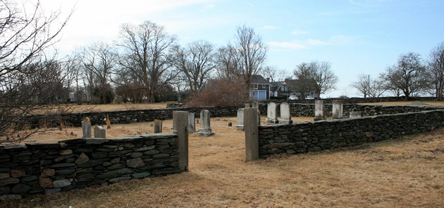 The will was recorded in Portsmouth and proved August 15, 1710, giving us a five month span of when William died. His death is recorded in both the Tiverton and Little Compton records, simply as 1710. Some researchers use the date April 15, as his death, but there isn't documentation to confirm this. The inventory of his estate was taken on July 17, 1710, and totaled 436 pounds, 12 shillings and 8p. Although William’s name is inscribed on the family monument (Cenotaph pictured above) of Benjamin Franklin Wilbour in the Seaconnet Cemetery (aka the New Wilbore Cemetery), William is most likely not interred there. He may be buried in the Old Wilbour Cemetery in Little Compton, pictured left, but more likely he was buried on his own land in Portsmouth. |
| ~< Back to Chart >~ |
Martha’s surname and ancestry are unknown. Some researchers say her surname was Potter, but documentation can’t be found to confirm this. For years it was thought she was the daughter of Rev. Obadiah Holmes and Catherine Hyde, but this has been most certainly, disproved. William and Martha had a comfortable life for the times. They made their home in Portsmouth and had at least ten children, all born in this area. Most of their years of birth are recorded in both the Little Compton and Tiverton Vital Records. Benjamin Franklin Wilbour (BFW) in his The English Ancestry of Samuel Wilbore, of Boston, and William Wilbore, of Portsmouth, R.I. that was published in volumes 112 and 113 of The New England Historical and Genealogical Register, tells us, “but on looking at the original records in Little Compton they are not to be found. They are, however, in Otis Wilbor's transcript of the records in Little Compton and are also given in the same way in a fairly modern book in Tiverton. . . This would seem to be the work of Otis Wilbor, who died in 1856, and consequently the births given are only approximate.” The children’s names are documented in William’s will – Mary about 1654, who married Joseph Mowry; Joseph about 1656, who married Ann Brownell; John about 1658, who married Hannah; Thomas about 1659, who married Mary, was probably dead by the time of his father’s will; William was born about 1660, and married Sarah Tallman; Martha, about 1662, who married William Shearman, the grandson of ancestor Philip Shearman; Samuel about 1664, who married Mary Potter; Daniel about 1666, who married Ann Barney; Joanna about 1668, who married Nathaniel Potter; and ancestor Benjamin. BFW states, “On examination of the Wilbore predigree we find that William names his first child Mary for his grandmother, his second child Joseph for his grandfather, his third child John for his father, the fourth child Thomas for his uncle, the fifth William for himself, the sixth Martha for his wife, the seventh Samuel for his cousin Samuel, the ninth Joanna for his mother, but as for Daniel and Benjamin, I cannot say where their names come from. Perhaps from Martha's side of the house. It can be seen that William for a while lacking daughters could not name a child for his mother, but just as soon as a daughter was born he named her Joanna.” It is not known when Martha Wilbore died, but she is not mentioned in her husband’s will, so she must have died before March 1, 1710. She probably died much earlier than that, as usually, but not always, on deeds for the sale of land, the wife of the seller signed and acknowledged the sale. On all of William’s sale deeds this researcher has found, beginning with December 20, 1687, he signed alone. This is a strong indication, but not confirmation, that Martha was dead by this date. Although she’s probably not buried there, her name is one of twelve ancestral names inscribed on the family monument (Cenotaph) of Benjamin Franklin Wilbour, who died in 1899, in the Seaconnet Cemetery in Little Compton. She was most likely buried on the land she lived on in Portsmouth. |
| ~< Back to Chart >~ |
Roger Kinnicut’s birth year is based upon an entry in volume 1 of Melinde Lutz Sanborn’s book, Ages from Court Records, 1636-1700: Essex, Middlesex, and Suffolk counties, Massachusetts. His name appears on a list for Middlesex County for 1669, where his age is given as 33 years old, setting his birth year around 1636. Most researchers have placed his birth about 1642 and some state that he came from Devonshire, England in about 1650, to New England. If this is the case, he came to the new world alone at eight years old. Being that Kinnicut is a rare name for New England at that time, it is unlikely he came with parents or siblings. It is more likely that he was at least 14 years old upon arrival. One researcher thinks he was from Teignmouth, and is trying to link him to Benjamin Kennicott, of Totnes, Devon, the eminent eighteenth century Christian Hebraist of Oxford. He may even be from a place in Devon called West Kennacott, near Barnstable, where many original settlers came from. His surname has been spelled many different ways including Kenicott, Kennicott, Kennicut, Kenicutt, Kinnicutt, Kinnecut, Kinicott, and Cenecut! So his ancestry will remain a mystery. Researchers have said that Roger lived in Salem, and Charlestown and then settled in Malden, Middlesex County, Massachusetts. The first record we have of him is his marriage in Malden to Joanna Shepardson in November of 1661. Malden records include their marriage and birth of three children. (See Joanna’s bio for more on this.) James Savage in Volume 3 of his book A Genealogical Dictionary of the First Settlers of New England states that Roger was made a freeman in 1670. But there are two entries in Henry Franklin’s book List of Freemen, Massachusetts Bay Colony from 1630 to 1691, for Roger. The first is dated May 11, 1670 for Roger Kenicot in Woburn, the other is for Roger Kennicot, dated May 31, 1671 in Malden. Roger worked as a carpenter and it seems he made a good living. In the History of Malden, Deloraine Pendre Corey tells us that Roger’s “farm was in the south-east portion of the town, apparently near Turkey Hill. . . . Besides the home land and house, it embraced meadow and marshlands at Moulton's Island and Pemberton's Pond near the South River, within Charlestown bounds.” Corey goes on to say that Roger Kenicott . . . of Malden was one of “about one hundred volunteers took the field under the old Jamaica privateer, Samuel Mosely of Dorchester.” In George Madison Bodge’s book, Soldiers in King Philip’s War, his name is listed as serving in June and July of 1675, being paid on September 3rd, of that year. What is very interesting is there is a Robert Kinnicot on this list, who was paid on September 14th in this same regiment. This may very well be a transcription error, and the name should have been Roger, or there was another man with the same surname. Bodge goes on to give us a detailed account of this regiment including, “and then all marched on and arrived at Swanzy, and quartered at Mr. Miles's Garrison-House close to the bridge leading to Mount Hope.” This is important because less than three years later, Roger sold his house and land on January 30, 1678 and moved the family to Swansea Bristol County, Massachusetts. The sale of his Estate to Lieut. John Smith of Boston is listed in Thomas Bellows Wyman’s book The Genealogies and Estates of Charlestown, as “house in Malden, lands in limits of Chas.--n, Molton island. . .” The three page deed listed in the Massachusetts Land Records, 1620-1986, Middlesex Deeds 1678-1684 volume 8 collection, states that on the date the deed was written, January 30, 1678, Roger had already left Malden and was living in Swanzey in the Colony of Plymouth. He sold all of his land, which seemed to be spread out in different areas, his house and all buildings for 85 pounds. Both Roger and Joanna’s marks are on the deed. The deed was recorded on August 9, 1682. Roger apparently purchased land and a house in Swansea, because in volume 1 of the Bristol Deeds 1686-1696 collection, we find a deed dated October 16, 1683, where Roger, carpenter, and his wife Joanna sold 40 acres for 20 pounds in Silver money to Robert Carter, another Swansea carpenter. In this deed his name is spelled both Kenecutt and Cenecut, but it is signed Kenecutt. Several researchers claim that this land is where Barrington, Rhode Island is today. We know from another deed mentioned below, that the land they owned was “by the Bay or Sea,” which describes the Barrington River with its salt water marshes. Wikipedia tells us that “Barrington was part of Swansea, Massachusetts from its incorporation in 1667 (part of the Plymouth Colony until the merger with Massachusetts in 1691).” Wikipedia goes on to say that “In 1747, Barrington was ceded to Rhode Island but made a part of Warren, Rhode Island. In 1770, its independence was restored by the Rhode Island legislature.” It is interesting to know that today, there is a Kinnicutt Ave, in Warren! The above deed, written on October 16, 1683, was recorded on April 26, 1694, leading many researchers to incorrectly assume Roger was alive in 1694. Roger actually died sometime after this deed was written and prior to October 4, 1692, the date a deed was written where his son John was called “Son and heir of Roger Kinnecut, Dec’d” and Joanna was called Widdow. This deed was recorded on January 27, 1695/6, again leading researchers astray. This researcher believes Roger died in 1692, inducing his wife to sell the land. |
| ~< Back to Chart >~ |
Joanna Shepardson was baptized on March 13, 1641/42, at the First Church in Charlestown, Suffolk County, Massachusetts, the third and youngest child born to Daniel and Joanna Shepardson. Her father died when she was only two years-old, and she was raised by her mother, without a father, until she was about 9 years-old. What should be pointed out here, is that an area called Mistick Side of Charlestown, where the Shepardson family lived, became Malden, in 1649. Joanna and Roger had at least six children, the first three are documented as being born in Malden, while the other births are not documented at all – Joanna in January 1663, who married Jonathan Finney in 1682; Lydia in January of 1666, who married Theophilus Luther in 1686; John in October of 1669, who married Elizabeth Luther; ancestor Mary; Elizabeth, who married Benjamin Whittemore in 1702; and Thomas, who married Hannah Bowerman in 1706. The birth order of the last three children is unknown, so they are listed in marriage year order. In 1675, her husband was fighting in King Philip’s War and a few years after his return, the family moved to Swansea in Bristol County. This is probably where the last three children were born. By October 4, 1692, her husband Roger was dead and she, with her 23 year-old eldest son, John, who was Roger’s heir, wrote a deed selling 1 ¾ of an acre of Salt Marsh Meadow on Twosett Neck Road in the Township of Swanzey, that bounded “westwardly by the Bay or Sea” for 7 pounds to Hugh Cole Jr., whose father was a boundary neighbor of the Kinicutts. This deed also tells us that daughter Joanna, who was now married to Jonathan Finney (spelled Phinney) , owned the land north of them. It seems possible that widow Joanna was still living in her house with her younger children and possibly with John and his wife. Three years later on October 19, 1695, another deed was written, selling 2 acres of Salt Marsh meadowlands and another half acre nearby to her son-in-law, Jonathan Pheney for 12 pounds, 10 shillings. In this deed, son John is called Husbandman, a farmer and Joanna, a widow. This is the last we hear of Joanna. Most researchers claim she died prior to 1701, but none say why they think that. |
| ~< Back to Chart >~ |
John Wilbur was born about 1592 in Braintree, Essex County, England, one of at least four sons born to Mary and Joseph Wilbore. Not much is known about John, as records are scarce. By the time John was of legal age, his father had died. In 1614, John inherited £10 from his uncle William Wilbore, which he probably received when the will was probated in 1615 or in 1616 when the will was proved. On August 6, 1616 John married Joan Drane in the Holy Cross Church in Felsted, Essex County (see Joan’s bio for children). His mother died in 1622, leaving a will written in 1620. In it she leaves to John, “. . . a brasse pott of a gallon and a kettell of two gallons two pewter dishes a pewte candle sticke and I give to Joan his wie a granny peticoat and my best waist coate.” John also received ⅓ share of his father’s estate, which was transferred to his mother and then to her three surviving sons. The estate included Hollis Grove, which is discussed below. John was in the textile trade, as were his ancestors before him. Karen Kupperman tells us in her book Providence Island 1630-1641 the Other Puritan Colony, “By the end of the 1620s, the Essex textile industry had fallen into a disastrous slump; huge stockpiles of unsold cloth meant no work for many.” So, it isn’t surprising that John Wilbore decides to leave Braintree. Benjamin Franklin Wilbour (BFW) in his English Ancestry of Samuel Wilbore, of Boston, and William Wilbore, of Portsmouth, R.I., states that “It was probably this John who, in 1631, signed his name to the agreement with several other Braintree men to join the settlement at the Isle of Old Providence, which is off the coast of South America.” BFW goes on to quote the Essex Records for Misc. papers relating to the Company of Adventurers to the Island of Providence as follows: “At Braintree. We whose names are hear underwritten do promise unto Thomas Barrington to goe with ye next shippe bound for ye Islae of Providence under his name, Signed, Thomas. Maynard. Henry Neale. Martin Cofield, Signed Jany 25, 1631. Signed alsoe the same day by me, John Wilbore.”
Life was difficult in the colony, it was ruled by absentee grandees who kept the settlers totally dependent on them. Besides the usual problems of setting up a new community, they had to build fortifications against possible attack by the Spanish; the tobacco they grew was of an inferior quality, but they insisted on growing it against the wishes of the directors; and as the four-year terms of the indentured servants expired, some demanded the right to use slaves, which caused a spilt in the colony. When the Spanish heard of the Providence Island Colony in 1635, they began to attack. It took them six years, but on May 25, 1641, they formally took possession and celebrated mass in the church. The Spanish captured the remaining 350 settlers, many others had escaped to the Mosquito Coast. They took the prisoners to Cartagena. The women and children were given passage back to England. It seems probable that the Wilbore’s fled to the Mosquito Coast and went back to England from there. The next we hear about John Wilbore is in 1642, when he and his two brothers, Nicholas and William were admitted to Hollis Grove, which was partly in Braintree and partly in Bocking. Hollis Grove was a grove of trees that John’s grandfather Nicholas left in his will to John’s father Joseph. John's two brothers, Nicholas and William, had sons who sold off their shares of Hollis Grove by 1667. BFW goes on to tell us that “The name Wilbore disappears from the manor rolls of Braintree in 1667.” Nothing is known of John or Joan after this. There is however, a will of a John Wilbore of Black Notley, husbandman, written in 1645 and proved on October 9, 1646, that just may be him. This researchers has not seen the contents of the will, so there is no evidence that this is our John. But it should be pointed out that Black Notley is less than 2 miles south of Braintree and after living in the Old Providence Island Colony, John just may have become a farmer. |
| ~< Back to Chart >~ |
Although John and Joan probably had other children, only two are known – the first child, John died as a baby in November, 1617 and is listed in the The First Register of Saint Mary's Church, Bocking, under the Burials, 1617, November heading as “Johanes Wilbore filius Johanis Wilbore sepultus 3.” This translates to “John Wilbore son of John Wilbore buried 3”; and ancestor William. She may have moved with her husband and child to the Old Providence Island Colony, or stayed behind in England. Whichever she did, she must have had a hard life. Unfortunately, nothing more is known about Joan Drane Wilbore. |
| ~< Back to Chart >~ |
Daniel Shepardson’s ancestry is unknown, but some researchers think he was born in Tring, Hertfordshire County, England, in about 1612, which is based on his estimated marriage date. Other researchers say he was born on June 8, 1613, the son of Thomas Shepardson and Mary Carter of Bramfield, Hertfordshire County, England. Still others think he may have come from Yorkshire County. Some say that he arrived in New England between 1626 and 1629, with his brother John, who died soon after. Documentation for any of this can’t be found. What we do know for sure is that on June 8, 1633, Daniel Shepheardson was admitted to the First Church in Charlestown, Suffolk County, Massachusetts. Records for him from 1633 until 1637 do not exist. He married Joanna, surname unknown, sometime before 1637, and they had three children together (see Joanna’s bio for more on this). Robert Charles Anderson’s The Great Migration Begins, tells us that “In 1637 ‘Dan[ie]ll Sheaperdson’ was recorded as having one and three-quarters cow commons.” Deloraine Pendre Corey’s The History of Malden, states that on April 23, 1638, a great allotment was made that “divided the lands of Mystic Side and a larger tract above the Mystic Ponds in that part of Charlestown which soon became Woburn, . . .” Daniel was recorded as receiving 10 acres on the Mystic Side, 20 acres above the Mystic Ponds, and that he did not have any land from the first allotment given out in 1633/4. The Charlestown Book of Possessions, called the City of Boston’s Document No. 39, states that on the “The first month, The 26: day” of 1638 the town was “to Record all pprieties ‘of Houses, Lands, Meadow or Pasture, as any Inhabitants of ye Towne.” This date, March 26, was just about one month prior to the great allotment. Then in December of the same year it states, “On the 28th day of the X month was taken A True Record of all such houses & Lands as are Possessed by the Inhabitnts of Charlstown, whethr by purchase, by gift from the Towne, or by allottments . . .” Daniel’s possessions were described in detail under the heading, “The Possession of Daniell Shepheardson in Charltowne limites.” His possessions were broken down into seven parcels: a house with a garden plot; five roods (1¼ acres) of fertile land in the east field; a one acre meadow in the high feilde mead, butting north upon the mistick river; 1¾ Cow Commons; about 5 acres in the line fielde, that bounded the high way; about 10 acres of woodland in the mistick feilde; and 25 acres in the waterfeilde. Daniel was a blacksmith, who earned a good living and owned a good amount of land. The authors of volume 1 of The Genealogical and Family History of the State of New Hampshire, say “ Like most Puritans he was intensely superstitious, a believer in signs and omens, and when one day, as he was working at his forge, a stone fell from it and crumbled to powder, he recognized the evil portent and gave to his wife the nails he was then making, saying, 'They will come in handy some day.' The nails were kept, and when he died they were used in making his coffin.” Daniel wrote his will on July 16, 1644. This researchers has not seen a copy of the full will, but pieces of it have been published in several books. The Great Migration Begins gives the most details, as follows: “In his will of 16 July 1644 ‘Daniell Shepardson of Charlestown in New England blacksmith’ left his estate to his wife during her life, and then after her decease ‘my house, with the garden, yard, & three acres of ground in the neck with my arms & tools to my son Daniell, whom I would have brought up in the trade of a smith,’ the rest to be divided between ‘my two daughters Lydia & Johanna,’ wife to be sole executrix, and ‘my Mr. Nowell, with brother Heburne & brother Cutler’ overseers; witnesses Thomas Carter and Rice Coles [SPR Case #28].”
“Final settlement of the estate was delayed for three years, at which time the General Court ordered a distribution different from that in the will, and probably for that reason the file for Daniel Shepardson includes two copies of his will along with the original. On one of these copies Increase Nowell, who wrote the original and both copies, adds at the bottom the following note: ‘If his wife & 3 children die he gave me Incr: Nowell his house & house plot; at the same time before the same witnesses.’ The inventory was taken 25 May 1647 by John Greene and Faithful Rouse, and totalled £49 17s., to which was added £7 12s. in miscellaneous items; of the total £35 12s. was seven parcels of real estate, of which the first and the last four match exactly his holdings in the Book of Possessions, and the second and third are close in description. The inventory also included ‘smith's tools £3 5s.’ and ‘a pair of smith's bellows £1 10s.’ [SPR Case #28]. On the next day, 26 May 1647, the General Court made the following order: ‘Upon presentment of the will & inventory of Daniell Shepardson it is ordered that the land should go according to the father's will to the son or recompense to the value of £25 10s. & because the mother hath been at great charge in educating the son three years & is still to be she should be allowed the tools & bellows & arms for that & that.the daughters shall have of what their father hath given them only to the value of nine pounds each of them for their part’ [SPR Case #28; MBCR 2:194].” |
| ~< Back to Chart >~ |
Joanna’s maiden name, birth date, and ancestry are unknown. The first reference to her is in the Records of the First Church in Charlestown, 1632-1789, where she is called Jone and Joanna, the wife of Daniell Shepheardson, in the baptism records of their children. Their children were baptized on the following dates – Lydia, the oldest on July 24, 1637; Daniel, the only son, on June 14, 1640; and ancestor Joanna. Joanna’s husband Daniel Shepardson died on July 26, 1644, leaving her with three young children. She did not hurry to remarry, but raised her children on her own. Two years later in 1646, along with many other area residents, Joanna Sheperson, sold “five acres more or less in Wenatomie alias Menotomy Field to Henry Dunster, President of the Coll.” Dunster was an Anglo-American Puritan clergyman, who became the first president of Harvard College in 1640. The deed, which was recorded many years later on January 17, 1654/5, states the land is “bounded with Cambridge boundes on one side, misticke pond, & River & Menatomie brooke . . .” This very well may be where Harvard University now stands. it is also interesting that although the deed says Sould, an amount of money is not stated.Joanna married widower Thomas Call Sr, but exactly when is not known. Corey’s History of Malden records the first known petition of Malden, dated October 28, 1651, which Joana Call had signed. She was one of thirty-six women who supported Marmaduke Matthews, the Malden puritan preacher who upset the established church in New England. This documents that Joanna was married by this date, raising her 9 to 14 year old children along with Thomas‘ children, the youngest being born in 1644. Two of Joanna’s children married into the Call family. Lydia married her step-brother Thomas Call Jr. in 1657; and Daniel, who did become a blacksmith, married his step-sister, widow Elizabeth Call Tingle in April of 1667. Joanna Shepardson Call died on January 30, 1661 in Malden. Her death record, in the name of Joanna Call, lists her spouse as Thomas Call Sen. Thomas lived another 16 years and died on May 17, 1676. |
| ~< Back to Chart >~ |
|
Joseph’s father died in 1583 and in his 1582 will, he calls Joseph, Josua. Nicholas leaves Joseph the house on the Gaunte that his family was already living in, “with the tenements thereto adjoining with their appurtenances thereto belonging” with the exception of £4 yearly to be given to his mother, “so longe as she is a widow.” Nicholas leaves his son Joseph his “grove called Halls grove” which was located partly in Braintree and partly in Bocking, and is later called Hollis Grove, but he had to supply his mother with “eighty loads of wood yearlye.” The last inheritance item for Joseph says that he was to receive £20 “of lawful money of England” yearly for three years. In the Epiphany, 1591, Session Rolls, under the heading of Jury panel for the body of the county, in the Essex Record Office files, there is an entry that reads “Henry Hedland, John Sadler, and Robert Doziter of Braintree, as mutual sureties, not to keep any victualling or tippling in their houses. Additional surety:- Joseph Wilbore of the same.” This seems to say they were not going to consume any alcohol, at home or in a restaurant, while serving on the jury. Joseph died without a will sometime prior to January 20, 1613, the date his brother William wrote his will and referenced him as “my brother Joseph Wilbore deceased.” It is not known for certain where he is buried, but it was probably in St Michael's churchyard, which no longer exists as a graveyard. |
| ~< Back to Chart >~ |
Mary’s surname and ancestry are unknown. All of what we know of her comes from her marriage and her will. She seemed to have a good life married to Joseph Wilbor. Mary and Joseph had four sons — Joseph, the eldest died young, as he was not mentioned in his Uncle William's will of 1613; Nicholas married a woman named Jane; ancestor John; and her youngest son, William, who married Margaret Dawson, died in 1660. Nicholas, John and William, all inherited money from their father’s brother, William Wilbore of Halstead.
“In the name of God Amen the tenth day of November Anno Dm 1620 and in the sixteenth yeare of the reign of our sovraigne Lord, James by the grace of God, King of England, France and Ireland the xthe of Scotland, defender of the ffaith Etc, I Marie Wilbore of Braintree in the county of Essex, widow being at this prsent in good health and pfect memory, thanks be given to all mightie God and revolking all former wills etc by me heretofore made, doe now make and declare this my psent last will and testament in manner and forme following. The will was signed with her mark, so she did not know how to write. Being that the will was proved in 1623, she probably died in 1622. |
| ~< Back to Chart >~ |
Nicholas Wilbore is said to have been born about 1504, in Colchester, Essex County, England. He is most likely the son of Thomas and Alice Wilbore. Benjamin Franklin Wilbour (BFW) in his English Ancestry . . states that Nicholas “was originally of Colchester, but in 1548 we find him in Braintree, when he sold Le stone house to John Jr., and Alice Wilbore of Colchester. He was very well to do with much real estate and other property in Braintree, Stisted, and Bocking. He evidently hired much help in the woolen business and also owned a large hill in Braintree which was used by him as pasturage for his sheep, called Skitts Hill.” He married a woman named Ann, see her bio for the children. Most of what we know of Nicholas comes from his will, which he wrote on November 26, 1582. (Mouse over and click on will image below right to enlarge in a new window/tab.) Nicholas names his wife and children, referring to ancestor Joseph as Josua. BFW transcribed the will, but it has been reformatted here for ease of reading, and is as follows: “In the name of God Amen, the xxviithe of Novembre in the yeare of our Lord one thousand fyve hundred eightie two and the fyve and twentieth yeare of Elizabeth bythe Grace of God of England Fraunce and Ireland, Queene defender of the faith etc. I Nicholas Wilbore of Braintree in the countye of Essex, draper, doe make this my last will and testament in manner and forme following. Nicholas Wilbore died sometime between the time he wrote his will in late November, 1582 and the date it was proved on September 16, 1583. It is assumed that his wishes were fulfilled and he was buried in St. Michael’s churchyard in Braintree. |
| ~< Back to Chart >~ |
Ann’s surname and ancestry are unknown. It is thought that she was born about 1508. It is said that she married Nicholas Wilbore about 1525 in Braintree, but no records exist to support this. What we know of her comes from her husband’s will, which seems to indicate he really wanted her to be safe and comfortable after his death. Nicholas and Ann had at least eight children together, all believed to be born in Braintree and lived their lives in Essex County – Their oldest son and heir, Thomas, described as a linen and woolen-draper in Essex deeds, married first Ann Goodaye and then a woman named Frances, and died in 1628; ancestor Joseph was the second son; William, a wealthy a woolen draper, married Ellen, died childless, left his estate to his siblings and their children, and was buried in St. Andrews churchyard in Halstead on October 1, 1616; Robert, also a draper, married Dorothy; Nicholas, married twice, was the father of Samuel who went to New England, and he was buried in Sible Hedingham on September 11, 1611; Susan married Robert Nicholson; Mary married John Lawrence; and Anne, who married Rycharde Baker on November 22, 1597, was buried in St. Mary’s churchyard in Bocking on October 31, 1624. The order of the sons and daughters is believed to be correct as listed, but it is not known if any one of the daughters is older than any of the sons. It is believed that Ann outlived her husband, as she was alive at the time he wrote his will in 1582, but her death date is not known. |
| ~<^>~ |
Thomas and Alice Wilbore are thought to be the ancestors of this Wilbore line. There are no records or proof, but Benjamin Franklin Wilbour (BFW), in his research, English Ancestry of Samuel Wilbore, of Boston, and William Wilbore, of Portsmouth, R.I., came to this tentative conclusion. He states “According to the oath book of Colchester, there were four Wilbores Who came to that place about 1500 from the West Riding of Yorkshire, Namely Nicholas Wilbore who was born in Middleton, Richard Wilbore who was born in Notton, Thomas Wilbore who was born in Royston, And John Wilbore who was born in Royston. . . . As Royston and Notton are in the same parish, the last three men were born practically in the same town, and as John and Richard Wilbore were both mentioned in the will of Nicholas Wilbore in 1557, it is safe to say that they were nearly related. . . . From all of the evidence it would seem that Thomas Wilbore was the father of John Wilbore Jr who married Alice Smith, Nicholas Wilbore who married Ann, and Joan Wilbore, the sister of Nicholas who married Ann, and who married George Brett, so I have placed them as such, in a tentative way. Nicholas Wilbore who made his will in 1557, had no son Nicholas, and John and Thomas Wilbore, unfortunately, had no wills, but if they had, it would probably have solved the difficulty.” This researcher would like to point out that earlier in this same article, BFW transcribed the 1557 will of Nicholas Wilbore and he does in fact have a son named Nicholas! Later in the same piece, BFW goes on to write a bio for this Nicholas and also for his son Nicholas Jr. Neither of them married a woman named Ann, so BFW is correct in saying that the 1557 Nicholas was not our Nicholas’ father. Another point of confusion is, why would someone be called John Jr, if his father’s name was Thomas? But Thomas and Alice may have been the parents of our Nicholas and his sister Joan, so we tentatively continue the line with them. The Oath Book, or as it is also known as, The Red Parchment Book of Colchester, gives us some insight into Thomas Wilbore. As early as 1544/5, he is listed in deeds and indentures involving John Wilbore and Alice, his wife. In 1549-1550, “Thos. Wylbore, b. at Ruston , Yorks., ‘teylour.’” is listed under the column, Burgesses. From 1557 to 1563, Thos. Wilbore, sometimes called tailor, is mentioned in deeds with various others, but his wife Alice is not mentioned. On January 20, 1564, there is an entry that states “Thomas Wylbore in court against Thomas Vincent for trespass, 4d.” Then on June 22, 1564, “Alice Wilbore, widow, and adm. of the goods and chattels of Thomas Wilbore, deceased v. George Wright for debt 11s 4d.” So Thomas died sometime between these two dates, and his wife survived him. A brief investigation into the West Riding records did not find any clarification or additional information. Being that we may never know if Thomas and Alice are the ancestors to this Wilbore line, the research stops with them. |
| ~< Back to Chart >~ |
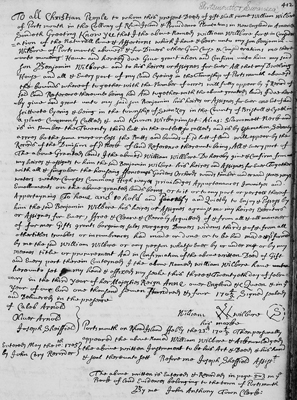
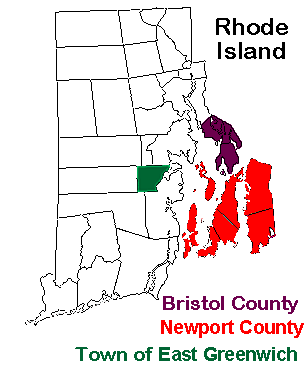 William bought and sold land frequently all over Bristol County, in what was then Massachusetts. In the Massachusetts Land Records, 1620-1986 here are at least six entries where he is either selling or giving away land and nine entries where he is buying land between 1681 and 1709, in several different towns as well as in his home town of Portsmouth. Not all the deeds are indexed, some are extremely hard to read, and some have been neatly copied. BFW continues in his America book to say “On May 5, 1693-4 the town of Portsmouth made an allotment of twelve acres of land for four and twenty shillings to William Wilbore of Portsmouth and bounded as follows: West by own land . . . It was probably on this farm that William had his house, for the land in the above deed mentioned as the Western boundary, as ‘own land,’ was called William Wilbore's garden. . . . It is evident from the above that William Wilbore was a large land owner in the Towns of Portsmouth, Tiverton, Little Compton, Swansea and Westport, and many of these lands he held until his death.” Mouse over image right to see a close up of a Newport County map.
William bought and sold land frequently all over Bristol County, in what was then Massachusetts. In the Massachusetts Land Records, 1620-1986 here are at least six entries where he is either selling or giving away land and nine entries where he is buying land between 1681 and 1709, in several different towns as well as in his home town of Portsmouth. Not all the deeds are indexed, some are extremely hard to read, and some have been neatly copied. BFW continues in his America book to say “On May 5, 1693-4 the town of Portsmouth made an allotment of twelve acres of land for four and twenty shillings to William Wilbore of Portsmouth and bounded as follows: West by own land . . . It was probably on this farm that William had his house, for the land in the above deed mentioned as the Western boundary, as ‘own land,’ was called William Wilbore's garden. . . . It is evident from the above that William Wilbore was a large land owner in the Towns of Portsmouth, Tiverton, Little Compton, Swansea and Westport, and many of these lands he held until his death.” Mouse over image right to see a close up of a Newport County map.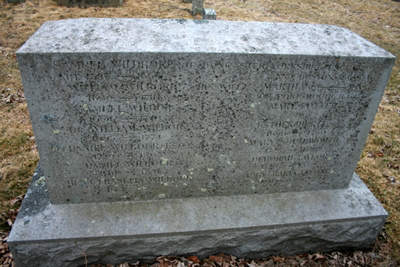
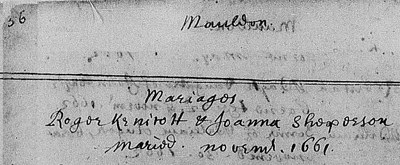 Joanna married Roger Kenicott in November of 1661 in Malden, Middlesex County, Massachusetts (mouse over image right). A little more than a year later, she made a deposition in, what we call today, a sexual abuse case on December 16, 1662 against a prominent man in Malden, William Bucknam. He was accused “of shameful laclviousness in his word and actions, towards sundry married women of Maulden, soliciting of them to undress & attempting their chastity…” She was listed as “the wife of Roger Kenicutt” on the list of the women who testified against him. He was found guilty and sentenced to be “severely whipt, Twenty stripes,” a fine of 25£, a bond of 50£, and had to pay the court costs. On April 2, 1663, only four months later, “Wm Bucknam is released from his bond for the good behavior.”
Joanna married Roger Kenicott in November of 1661 in Malden, Middlesex County, Massachusetts (mouse over image right). A little more than a year later, she made a deposition in, what we call today, a sexual abuse case on December 16, 1662 against a prominent man in Malden, William Bucknam. He was accused “of shameful laclviousness in his word and actions, towards sundry married women of Maulden, soliciting of them to undress & attempting their chastity…” She was listed as “the wife of Roger Kenicutt” on the list of the women who testified against him. He was found guilty and sentenced to be “severely whipt, Twenty stripes,” a fine of 25£, a bond of 50£, and had to pay the court costs. On April 2, 1663, only four months later, “Wm Bucknam is released from his bond for the good behavior.” 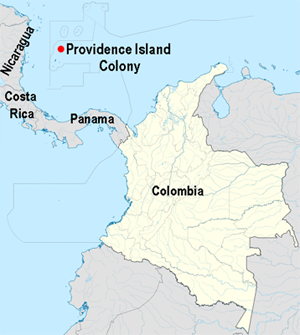 Wikipedia tells us that British ships first visited the Isle of Old Providence, which is one hundred miles east of the Mosquito coast, in 1628. The Providence Island Company was set up because they thought that the island would become the leading Puritan colony in the New World since its climate was far superior to that of the Massachusetts Bay Colony, which was founded the same year. Many English Puritans went there, some as indentured servants, to build new lives. Peter Wilson Coldham in his book, The Complete Book of Emigrants: 1607-1660, states that the November 22, 1630 minutes of the Providence Island Company reads, “Each adventurer is to obtain as many men and boys as are willing to serve and the good ones are to be shipped next January. . . Apprentices over 14 years old are to be taken for a term of years and to be allowed £5 a year wages.” On the February 2, 1631 minutes, Coldham states it read, “Captain William Rudyerd appointed commander of all the passengers in the Seaflower bound for Providence Island.” Seaflower was probably the ship that John Wilbore traveled on to the new colony. It is not known for certain if his wife and five year-old son, ancestor William, went with him, as until 1635 the company discouraged planters from bringing their wives and children. Alison Games, in her book, Migration and the Origins of the English Atlantic World, tells us that “. . . there were at least some small children traveling with their parents, . . .” Joan could have taken her son with her in 1635 to join her husband, as that year, there was a midwife aboard the Expectation, bound for Old Providence.
Wikipedia tells us that British ships first visited the Isle of Old Providence, which is one hundred miles east of the Mosquito coast, in 1628. The Providence Island Company was set up because they thought that the island would become the leading Puritan colony in the New World since its climate was far superior to that of the Massachusetts Bay Colony, which was founded the same year. Many English Puritans went there, some as indentured servants, to build new lives. Peter Wilson Coldham in his book, The Complete Book of Emigrants: 1607-1660, states that the November 22, 1630 minutes of the Providence Island Company reads, “Each adventurer is to obtain as many men and boys as are willing to serve and the good ones are to be shipped next January. . . Apprentices over 14 years old are to be taken for a term of years and to be allowed £5 a year wages.” On the February 2, 1631 minutes, Coldham states it read, “Captain William Rudyerd appointed commander of all the passengers in the Seaflower bound for Providence Island.” Seaflower was probably the ship that John Wilbore traveled on to the new colony. It is not known for certain if his wife and five year-old son, ancestor William, went with him, as until 1635 the company discouraged planters from bringing their wives and children. Alison Games, in her book, Migration and the Origins of the English Atlantic World, tells us that “. . . there were at least some small children traveling with their parents, . . .” Joan could have taken her son with her in 1635 to join her husband, as that year, there was a midwife aboard the Expectation, bound for Old Providence.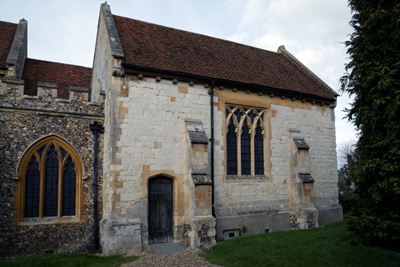 Joan Drane’s ancestry is unknown. It is thought she was born about 1598, almost certainly in England, and maybe in or near Felsted, Essex County, as there were many with her surname in that town at the time. The first record we have of her is in Latin from the Felsted Holy Cross Church Marriage Register, under the year 1616 as follows, “Johannes Wilbor et Johanna Drane matrimonium public contraxerunt sext die August,” which roughly translates to John Wilbor and Joan Drane publicly contracted marriage on August 6th. For all we know, her given name may have been Johanna. Mouse over the image right of the South Chapel of Holy Cross Church, for more info.
Joan Drane’s ancestry is unknown. It is thought she was born about 1598, almost certainly in England, and maybe in or near Felsted, Essex County, as there were many with her surname in that town at the time. The first record we have of her is in Latin from the Felsted Holy Cross Church Marriage Register, under the year 1616 as follows, “Johannes Wilbor et Johanna Drane matrimonium public contraxerunt sext die August,” which roughly translates to John Wilbor and Joan Drane publicly contracted marriage on August 6th. For all we know, her given name may have been Johanna. Mouse over the image right of the South Chapel of Holy Cross Church, for more info. Daniel Shepardson died on July 26, 1644, just ten days after writing his will. (Mouse over image right.) He left his wife with three young children, ages 2 to 7 years-old. The will was recorded as case # 28 in the Suffolk County Probate Records. Anderson’s Great Migration continues with details about the probate settlement as follows:
Daniel Shepardson died on July 26, 1644, just ten days after writing his will. (Mouse over image right.) He left his wife with three young children, ages 2 to 7 years-old. The will was recorded as case # 28 in the Suffolk County Probate Records. Anderson’s Great Migration continues with details about the probate settlement as follows: 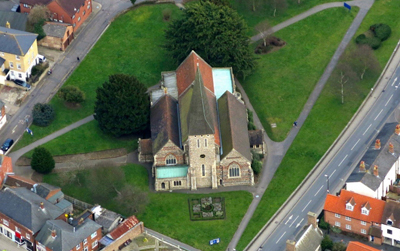 Joseph Wilbore was most likely born in Braintree, Essex County, England, the second of eight children born to Nicholas and Ann Wilbore. He married Mary, about 1571, in Braintree, and they had at least four sons (see Mary’s bio for the children). The family made their home in a house on the Gaunte that belonged to Joseph’s father, who let them live there. The Gaunte is described by Benjamin Franklin Wilbour as “a passageway on the south of the church of St. Michaels.” Mouse over the image to the right for more info.
Joseph Wilbore was most likely born in Braintree, Essex County, England, the second of eight children born to Nicholas and Ann Wilbore. He married Mary, about 1571, in Braintree, and they had at least four sons (see Mary’s bio for the children). The family made their home in a house on the Gaunte that belonged to Joseph’s father, who let them live there. The Gaunte is described by Benjamin Franklin Wilbour as “a passageway on the south of the church of St. Michaels.” Mouse over the image to the right for more info.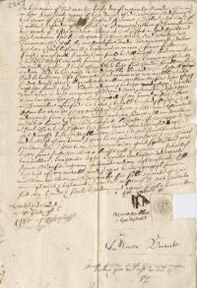 Benjamin Franklin Wilbour (BFW) in his The English Ancestry of Samuel Wilbore, of Boston, and William Wilbore, of Portsmouth, R.I., that was published in volume 113 of the New England Historical & Genealogical Register, states “According to the Braintree Manor Rolls in 1622 Hollis Grove went to widow Mary as tennant and then to her three sons . . .” So it seems that right before she died, her husband’s estate was settled and she received his holdings, as she doesn’t mention the grove in her will, which was written two years earlier. Mary wrote her will using the name Marie on December 10, 1620, but the cover page of the will says Mary (mouse over image right). BFW transcribed her will as follows, but it is printed here reformatted for ease of reading. Note, BFW used the @ for the &:
Benjamin Franklin Wilbour (BFW) in his The English Ancestry of Samuel Wilbore, of Boston, and William Wilbore, of Portsmouth, R.I., that was published in volume 113 of the New England Historical & Genealogical Register, states “According to the Braintree Manor Rolls in 1622 Hollis Grove went to widow Mary as tennant and then to her three sons . . .” So it seems that right before she died, her husband’s estate was settled and she received his holdings, as she doesn’t mention the grove in her will, which was written two years earlier. Mary wrote her will using the name Marie on December 10, 1620, but the cover page of the will says Mary (mouse over image right). BFW transcribed her will as follows, but it is printed here reformatted for ease of reading. Note, BFW used the @ for the &: